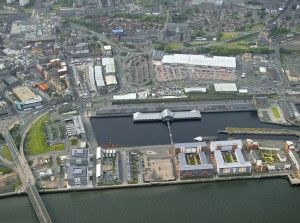Chris Kelly attended the recent SURF conference on Truths and Myths in Infrastructure and Social Benefits. In providing SURF with feedback on the event, he felt that there was too narrow a focus on ‘hard’ social outcomes like employment and training. SURF agreed and invited him to elaborate. In this blog article, he argues that community benefit clauses are not the only route to developing wider social impacts from infrastructure investments
“The first question that we should ask when developing any contract specification should be: ‘Can we include a community benefit clause?‘” John Swinney, Cabinet Secretary for Finance and Sustainable Growth, March 2010.
Over the last few years, there has been much political and strategic focus to encourage and deliver community benefit clauses through the procurement of public sector projects/contracts, and also to encourage the private sector to contribute to the agenda through contractual clauses.
In the context of urban regeneration, community benefits generally involve working with local partners like a local FE College or job centre to create apprenticeship, training, employment or volunteering opportunities during the construction and future operational phases. There are numerous regeneration projects across Scotland that have delivered these types of community benefits – including those presented at the recent SURF event (Dundee Waterfront, Clyde Gateway, Aberdeen City Council, Glasgow Housing Association, and the Commonwealth Games legacy).
However… while these employment and training focused community benefits are important, there are a wide range of other social impacts that can be generated through successful and sustainable regeneration.

Cabinet Secretary John Swinney is a keen proponent of community benefit clauses.
Often, regeneration projects (and the bodies delivering them) are too heavily focused on delivering and capturing the ‘hard’ economic impacts – jobs and gross value added. Through a holistic approach that goes beyond purely physical regeneration and investment in infrastructure, we have the opportunity to deliver a range of wider social impacts.
One of the issues with defining or measuring social impact is that the intended (and unintended) impacts are often so varied from project to project and are typically qualitative in nature. We need to improve our understanding of what types of wider social impact can be delivered through regeneration and infrastructure investment so that we can identify, prioritise and promote them as best practice for others.
One of the key first steps in defining the wider social impacts of urban regeneration is getting people and delivery bodies talking, discussing and debating. What types of community/social benefit have different agencies been able to generate through their regeneration projects? What worked well and not so well? Did collaboration with partners deliver better impacts? What different groups were targeted? How did delivery bodies gain community support?
As an economic development consultant, I have had the opportunity to be involved in appraising and evaluating a wide range of successful regeneration and place development projects across the UK – both public and private sector led. Based on this experience, I am highlighting five key social impacts that I believe can be achieved through a holistic approach to regeneration:
- Improve the health and wellbeing outlook of local people: through the delivery of direct services e.g. new or better integrated health services or indirectly through, for example, giving people access to a greater choice of physical activities which has a positive impact on their physical health, mental wellbeing and quality of life.
- Enhancing civic pride and public perception: through creating ‘good places’ to live, work and socialise. Delivery of good quality public realm, green/open/civic space can all have positive impacts on improving the civic pride of local people, and help change the external perception and stigma attached to areas that have long suffered from deprivation.
- Change the feel of the area: physical improvements and ‘good design’ can make an area feel more vibrant, and feel safer for local people through removing the fear of crime and reducing anti-social behaviour.
- Capacity building and generating social capital: working with and supporting the local community and groups to enable capacity building and community empowerment. It is important that local communities are encouraged, supported and empowered to come together and take a greater role in improving their communities.
- Improving access to opportunities: to important services, facilities, employment/training opportunities, cultural, retail leisure facilities etc. Regeneration should link residential areas with the wider community.
Within this, it is important to consider the individual groups that may benefit, for example, entire communities, local businesses and services, woman, ethnic minorities, those considered to have a disability, young people, and those in long-term unemployment. Different projects will have different target audiences. The important issue is to understand who they are, what barriers they face and how regeneration projects can address these constraints.

The £1bn Dundee Waterfront regeneration project was featured in SURF’s recent conference.
This is by no means an exhaustive list of social impacts, but the fact we are unable to compile a comprehensive list of potential impacts shows that successful regeneration projects have the potential to impact positively on so many different aspects of society.
So, once we have identified the types of social impact the next key question is: how do we measure and capture social impact? Over recent few years there have been a number of tools developed including the Social Return on Investment (SROI) model and Health Economic Assessment Tool (HEAT). These models help identify and assign quantifiable values to positive changes in society and are a valuable mechanism to allow social impacts to be considered as a key outcome of regeneration.
That being said, the best way to understand the wider impact of regeneration is to speak to, and engage with, your stakeholders – the groups and organisations on the ground, and the people and communities that the regeneration projects are designed to effect a positive change within.

There is debate (as covered at the recent SURF event) about the most effective type of regeneration. Is it top down, large investment, and public-sector led? Or bottom up, small community based initiatives? This is a debate that is worth having, but for me the answer is both. We need high level infrastructure investment to attract interest from the private sector and stimulate economic growth, but we also need to engage with communities and partner organisations on the ground to help deliver targeted initiatives that will deliver and embed social benefits for local people. These two key pillars of delivering regeneration need to be intertwined to achieve long-term social change.
Are community benefits clauses a worthwhile framework for delivering local level impacts? Yes, undoubtedly …but is there more to delivering successful regeneration and generating social impacts? Yes, absolutely!
